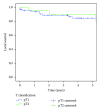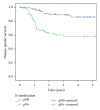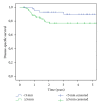Primary surgical therapy for locally limited oral tongue cancer
- PMID: 24967399
- PMCID: PMC4054785
- DOI: 10.1155/2014/738716
Primary surgical therapy for locally limited oral tongue cancer
Abstract
Objectives: The aim of this study was to assess the efficacy of primary surgical treatment in the management of locally limited oral tongue carcinoma.
Methods: A retrospective evaluation was carried out for all patients treated with primary surgery for pT1-pT2 oral tongue carcinomas at a tertiary referral center between 1980 and 2005. All cases were assessed for disease-specific survival and local control rates in relation to T classification, N classification, infiltration depth of the primary tumor, and decision making on neck management and adjuvant therapy. The cases were additionally evaluated for the incidence of major complications and tracheotomies.
Results: 263 cases were assessed. The 5-year disease-specific survival rate was 75.2%. Positive neck disease was shown to be a significant negative prognostic factor. The occult metastasis rate was 20.2%.
Conclusions: Primary surgical treatment is a very effective modality against T1-T2 oral tongue carcinoma, and a low rate of complications can be anticipated.
Figures



References
-
- Veness MJ, Morgan GJ, Sathiyaseelan Y, Gebski V. Anterior tongue cancer and the incidence of cervical lymph node metastases with increasing tumour thickness: should elective treatment to the neck be standard practice in all patients? ANZ Journal of Surgery. 2005;75(3):101–105. - PubMed
-
- Yuen APW, Lam KY, Lam LK, et al. Prognostic factors of clinically stage I and II oral tongue carcinoma—a comparative study of stage, thickness, shape, growth pattern, invasive front malignancy grading, Martinez-Gimeno score, and pathologic features. Head and Neck. 2002;24(6):513–520. - PubMed
-
- Yuen APW, Lam KY, Chan ACL, et al. Clinicopathological analysis of elective neck dissection for no neck of early oral tongue carcinoma. American Journal of Surgery. 1999;177(1):90–92. - PubMed
-
- Psychogios G, Mantsopoulos K, Bohr C, Koch M, Zenk J, Iro H. Incidence of occult cervical metastasis in head and neck carcinomas: development over time. Journal of Surgical Oncology. 2013;107(4):384–387. - PubMed
-
- Gospodarowitz M, Wittekind C, Sobin L. TNM Classification of Malignant Tumours. New York, NY, USA: John Wiley & Sons; 2009. AJCC cancer staging manual.
Publication types
MeSH terms
LinkOut - more resources
Full Text Sources
Other Literature Sources

